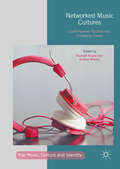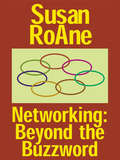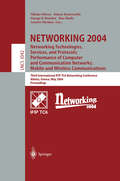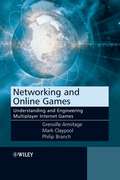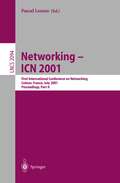- Table View
- List View
Networked Control Under Communication Constraints: A Time-Delay Approach (Advances in Delays and Dynamics #11)
by Kun Liu Emilia Fridman Yuanqing XiaThis book presents a time-delay approach to the analysis and synthesis of networked control systems (NCSs) under communication constraints. Differently from other approaches, the time-delay approach to NCSs allows communication delays to be larger than the sampling intervals in the presence of scheduling protocols. The book starts from a comprehensive introduction to three main approaches to sampled-data and networked control. It then focuses on time-delay approach, and the modelling of the closed-loop systems in the form of time-delay system. It presents discontinuous (in time) Lyapunov functional constructions that are efficient for NCSs in the presence of communications delays. Further, it highlights time-delay approaches developed to model and analyze NCSs under communication constraints, with a particular focus on dynamic quantization, round-robin, try-once-discard and stochastic protocols. The results are first presented for the continuous-time NCSs and then extended to discrete-time NCSs. Discussing recent developments in Lyapunov-based analysis of NCSs under communication constraints, the book is a valuable resource for researchers interested in sampled-data and networked control, and time-delay systems, as well as for graduate students in automatic control and systems theory.
Networked Group Communication: Third International COST264 Workshop, NGC 2001, London, UK, November 7-9, 2001. Proceedings (Lecture Notes in Computer Science #2233)
by Jon Crowcroft Markus HofmannNetworked Group Communication: First International COST264 Workshop, NGC'99, Pisa, Italy, November 17-20, 1999 Proceedings (Lecture Notes in Computer Science #1736)
by Luigi Rizzo Serge FdidaEnabling group communication is one of the major challenges for the future Internet. Various issues ranging from services and applications to protocols and infrastructure have to be addressed. Moreover, they need to be studied from various angles and therefore involve skills in multiple areas. COST264wascreatedtocontributetothisinternationale?orttowardsgroup communication and related technologies. The European COST framework is ideal for establishing a new community of interest, providing an open forum for ideas, and also supporting young researchers in the ?eld. The COST264 action, o?cially started in late 1998, aims at leveraging the European research in this areaandcreatingintensiveinteractionattheinternationallevel.Tothispurpose, COST264 decided to organize an annual technical workshop, the “International Workshop on Networked Group Communication”. NGC’99 in Pisa is the ?rst event of the series. Despitethisbeingthe?rstworkshopanddespitetheveryshorttimebetween the Call for Papers and the deadline for submissions, and the other con?icting andmoreestablishedevents,theCallforPapersofNGC’99washighlysuccessful: we received 49 papers, of which 18 were selected to compose the basis of the technical program. We hope you will enjoy our paper selection, which is the VI Preface core of these proceedings, and addresses important issues in the research and development of networked group communication. In addition to refereed contributions, we scheduled two keynote speakers (Christophe Diot and Steve Deering), and four invited talks by Ken Birman (Cornell), Bob Briscoe (BT), Radia Perlman (SUN), Tony Speakman (CISCO).
Networked Music Cultures: Contemporary Approaches, Emerging Issues (Pop Music, Culture and Identity)
by Raphaël Nowak Andrew WhelanThis collection presents a range of essays on contemporary music distribution and consumption patterns and practices. The contributors to the collection use a variety of theoretical and methodological approaches, discussing the consequences and effects of the digital distribution of music as it is manifested in specific cultural contexts.The widespread circulation of music in digital form has far-reaching consequences: not least for how we understand the practices of sourcing and consuming music, the political economy of the music industries, and the relationships between format and aesthetics. Through close empirical engagement with a variety of contexts and analytical frames, the contributors to this collection demonstrate that the changes associated with networked music are always situationally specific, sometimes contentious, and often unexpected in their implications. With chapters covering topics such as the business models of streaming audio, policy and professional discourses around the changing digital music market, the creative affordances of format and circulation, and local practices of accessing and engaging with music in a range of distinct cultural contexts, the book presents an overview of the themes, topics and approaches found in current social and cultural research on the relations between music and digital technology.
Networked Neighbourhoods: The Connected Community in Context
by Patrick PurcellThe setting for this book is the networked community. The treatment of the subject matter is broad and interdisciplinary, with contributions from computer science, sociology, design, human factors and communication technology. The chapter contributors, drawn from across Europe and North America, offer a varied
Networked Predictive Control of Systems with Communication Constraints and Cyber Attacks
by Zhong-Hua Pang Guo-Ping Liu Donghua Zhou Dehui SunThis book presents the latest results on predictive control of networked systems, where communication constraints (e.g., network-induced delays and packet dropouts) and cyber attacks (e.g., deception attacks and denial-of-service attacks) are considered. For the former, it proposes several networked predictive control (NPC) methods based on input-output models and state-space models respectively. For the latter, it designs secure NPC schemes from the perspectives of information security and real-time control. Furthermore, it uses practical experiments to demonstrate the effectiveness and applicability of all the methods, bridging the gap between control theory and practical applications. The book is of interest to academic researchers, R&D engineers, and graduate students in control engineering, networked control systems and cyber-physical systems.
A Networked Self: Identity, Community, and Culture on Social Network Sites (A Networked Self)
by Zizi PapacharissiA Networked Self examines self presentation and social connection in the digital age. This collection brings together new work on online social networks by leading scholars from a variety of disciplines. The focus of the volume rests on the construction of the self, and what happens to self-identity when it is presented through networks of social connections in new media environments. The volume is structured around the core themes of identity, community, and culture – the central themes of social network sites. Contributors address theory, research, and practical implications of many aspects of online social networks including self-presentation, behavioral norms, patterns and routines, social impact, privacy, class/gender/race divides, taste cultures online, uses of social networking sites within organizations, activism, civic engagement and political impact.
A Networked Self: Identity, Community, and Culture on Social Network Sites (A Networked Self)
by Zizi PapacharissiA Networked Self examines self presentation and social connection in the digital age. This collection brings together new work on online social networks by leading scholars from a variety of disciplines. The focus of the volume rests on the construction of the self, and what happens to self-identity when it is presented through networks of social connections in new media environments. The volume is structured around the core themes of identity, community, and culture – the central themes of social network sites. Contributors address theory, research, and practical implications of many aspects of online social networks including self-presentation, behavioral norms, patterns and routines, social impact, privacy, class/gender/race divides, taste cultures online, uses of social networking sites within organizations, activism, civic engagement and political impact.
Networked Sensing Information and Control
by Venkatesh SaligramaThis book presents research on informational and mathematical aspects of networked sensing systems. It brings together internationally reputed researchers from different communities, focused on the common theme of distributed sensing, inferencing, and control over networks. The timeliness of the book is evidenced by the explosion of several independent special sessions devoted to specific aspects of sensor networks in reputed international conferences.
Networking: Beyond the Buzz Word - Biz Books to Go
by Susan RoAneWith Networking: Beyond the Buzzword, available only as an eBook, bestselling author, in-demand keynote speaker, and The Mingling Maven, Susan RoAne, unlocks the secrets to that one skill everyone wants, but no one feels they have. With her characteristic sense of humor and style, RoAne offers veteran advice on everything you need to know to make valuable business connections in and outside the workplace. Through proven strategies and simple steps, RoAne shows how anyone can: *learn to identify and utilize a pre-existing network of contacts; *avoid becoming a "nudge" networker; *acquire valuable referrals; *get the "dos" and "don'ts" of networking both on- and offline; *pick up advice on how to work trade shows and conferences; *create connections that result in lifelong friendships; *receive the low-down on gender differences in networking; *and much more. RoAne even offers a Yiddish glossary so readers can distinguish the mavens from the kvetchers. Whether you're a novice or an experienced networker looking to further unlock the savvy person within, RoAne shows you how to build a safety net of support, information and relationships.
NETWORKING 2000. Broadband Communications, High Performance Networking, and Performance of Communication Networks: IFIP-TC6/European Commission International Conference Paris, France, May 14-19, 2000 Proceedings (Lecture Notes in Computer Science #1815)
by Guy Pujolle Harry Perros Serge Fdida Ulf Körner Ioannis StavrakakisThis was the first conference jointly organized by the IFIP Working Groups 6. 2, 6. 3, and 6. 4. Each of these three Working Groups has its own established series of conferences. Working Group 6. 2 sponsors the Broadband Communications series of conferences (Paris 1995, Montreal 1996, Lisboa 1997, Stuttgart 1998, and Hong-Kong 1999). Working Group 6. 3 sponsors the Performance of Communication Systems series of conferences (Paris 1981, Zürich 1984, Rio de Janeiro 1987, Barcelona 1990, Raleigh 1993, Istanbul 1995, and Lund 1998). Working Group 6. 4 sponsors the High Performance Networking series of conferences (Aaren 1987, Liège 1988, Berlin 1990, Liège 1992, Grenoble 1994, Palma 1995, New York 1997, Vienna 1998). It is expected that this new joint conference will take place every two years. In view of the three sponsoring Working Groups, there were three separate tracks, one per Working Group. Each track was handled by a different co chairman. Specifically, the track of Working Group 6. 2 was handled by Ulf Körner, the track of Working Group 6. 3 was handled by Ioanis Stavrakakis, and the track of Working Group 6. 4 was handled by Serge Fdida. The overall program committee chairman was Harry Perros, and the general conference chairman was Guy Pujolle. A total of 209 papers were submitted to the conference of which 82 were accepted. Each paper was submitted to one of the three tracks.
NETWORKING 2002: Second International IFIP-TC6 Networking Conference, Pisa, Italy, May 19-24, 2002 Proceedings (Lecture Notes in Computer Science #2345)
by Enrico Gregori Marco Conti Andrew T. Cambell Guy Omidyar Moshe ZukermanThis book constitutes the refereed proceedings of the Second IFIP-TC6 Netw- king Conference, Networking 2002. Networking 2002 was sponsored bythe IFIP Working Groups 6.2, 6.3, and 6.8. For this reason the conference was structured into three tracks: i) Networking Technologies, Services, and Protocols, ii) Perf- mance of Computer and Communication Networks, and iii) Mobile and Wireless Communications. This year the conference received 314 submissions coming from 42 countries from all ?ve continents Africa (4), Asia (84), America (63), Europe (158), and Oc- nia (5). This represents a 50% increase in submissions over the ?rst conference, thus indicating that Networking is becoming a reference conference for wor- wide researchers in the networking community. With so manypapers to choose from, the job of the Technical Program C- mittee, to provide a conference program of the highest technical excellence, was both challenging and time consuming. From the 314 submissions, we ?nallys- ected 82 full papers for presentation during the conference technical sessions. To give young researchers and researchers from emerging countries the oppor- nityto present their work and to receive useful feedback from participants, we decided to include two poster sessions during the technical program. Thirty-one short papers were selected for presentation during the poster sessions. The conference technical program was split into three days, and included, in addition to the 82 refereed contributions, 5 invited papers from top-level rese- chers in the networking community.
NETWORKING 2004: Networking Technologies, Services, and Protocols; Performance of Computer and Communication Networks; Mobile and Wireless Communications Third International IFIP-TC6 Networking Conference Athens, Greece, May 9–14, 2004, Proceedings (Lecture Notes in Computer Science #3042)
by Nikolas Mitrou Kimon Kontovasilis George Rouskas Ilias Iliadis Lazaros MerakosThis book contains the refereed proceedings of the 3rd International IFIP-TC6 Networking Conference, Networking 2004. Conferences in the Networking series span the interests of several distinct, but related, TC6 working groups, including Working Groups 6.2, 6.3, and 6.8. Re?ecting this, the conference was structured with three Special Tracks: (i) Networking Technologies, Services, and Protocols; (ii) Performance of Computer and Communication Networks; and (iii) Mobile and Wireless Communications. However, beyond providing a forum for the presentation of high-quality - search in various complementary aspects of networking, the conference was also targetedtocontributingtoauni?edviewofthe?eldandtofosteringtheinter- tion and exchange of fruitful ideas between the various related (and overlapping) specialized subcommunities therein. Towards this second objective, more than a few conference sessions (and thematic sections in this book) ‘cut across’ the Special Tracks, along more generic or fundamental concepts. Networking 2004 was fortunate to attract very high interest among the c- munity, and the conference received 539 submissions from 44 countries in all ?ve continents. These ?gures correspond to a remarkable increase in subm- sions from the previous very successful events (roughly, a 156% increase over Networking 2000 and 71% over Networking 2002), and indicate that Netw- king conferences are progressively becoming established as worldwide reference events in the ?eld.
NETWORKING 2005. Networking Technologies, Services, and Protocols; Performance of Computer and Communication Networks; Mobile and Wireless Communications Systems: 4th International IFIP-TC6 Networking Conference, Waterloo, Canada, May 2-6, 2005, Proceedings (Lecture Notes in Computer Science #3462)
by Raouf Boutaba Kevin Almeroth Ramon Puigjaner Sherman Shen James P. BlackNETWORKING 2006. Networking Technologies, Services, Protocols; Performance of Computer and Communication Networks; Mobile and Wireless Communications Systems: 5th International IFIP-TC6 Networking Conference, Coimbra, Portugal, May 15-19, 2006, Proceedings (Lecture Notes in Computer Science #3976)
by Fernando Boavida Thomas Plagemann Burkhard Stiller Cedric Westphal Edmundo MonteiroHere are the refereed proceedings of the 5th International IFIP-TC6 Networking Conference, NETWORKING 2006. The 88 revised full papers and 31 poster papers are organized in topical sections on caching and content management, mobile ad-hoc networks, mobility/handoff, monitoring/measurements, multicast, multimedia, optical networks, peer-to-peer, resource management and QoS, routing, topology and location awareness, traffic engineering, transport protocols, wireless networks, and wireless sensor networks.
NETWORKING 2007. Ad Hoc and Sensor Networks, Wireless Networks, Next Generation Internet: 6th International IFIP-TC6 Networking Conference, Atlanta, GA, USA, May 14-18, 2007, Proceedings (Lecture Notes in Computer Science #4479)
by Ian F. Akyildiz Raghupathy Sivakumar Eylem Ekici Jaudelice Cavalcante De Oliveira Janise McNairThis book constitutes the refereed proceedings of the 6th International IFIP-TC6 Networking Conference, NETWORKING 2007, held in Atlanta, GA, USA in May 2007. The 99 revised full papers and 30 poster papers cover ad hoc and sensor networks, wireless networks, and the next generation internet.
NETWORKING 2008 Ad Hoc and Sensor Networks, Wireless Networks, Next Generation Internet: 7th International IFIP-TC6 Networking Conference Singapore, May 5-9, 2008, Proceedings (Lecture Notes in Computer Science #4982)
by Amitabha Das Hung Keng Pung Francis Bu Sung Lee Lawrence Wong Wai ChoongThis book constitutes the refereed proceedings of the 7th International IFIP-TC6 Networking Conference, NETWORKING 2008, held in Singapore, in May 2008. The 82 revised full papers were carefully reviewed and selected from numerous submissions for inclusion in the book. The papers are organized in topical sections on ad hoc and sensor networks: design and optimization, MAC protocol, overlay networking, and routing; next generation internet: authentication, modeling and performance evaluation, multicast, network measurement and testbed, optical networks, peer-to-peer and overlay networking, peer-to-peer services, QoS, routing, security, traffic engineering, and transport protocols; wireless networks: MAC performance, mesh networks, and mixed networks.
NETWORKING 2009: 8th International IFIP-TC 6 Networking Conference, Aachen, Germany, May 11-15, 2009, Proceedings (Lecture Notes in Computer Science #5550)
by Luigi Fratta Henning Schulzrinne Yutaka Takahashi Otto Spaniol“What a di?erence a year makes – 52 little weeks” This variation of the ?rst line from Dinah Washington’s famous song, which originally reads, “What a di?erence a day makes - 24 little hours,” brings it to the point: Accordingtoallexperts,thepress,andmostpeople’simpressionwearetoday in a serious economic recession. Less than one year ago, we practically lived on the “island of the blessed” (namely, at Networking 2008 that was held on the island of Singapore), or in the famous country where “milk and honey ?ow” (or “where wine and liquor ?ow”). This convenient situation has changed abruptly within less than 52 weeks. It looks like the same kind of problems has emerged in all areas – and the “Networking” area has, of course, been a?ected, too. Looking into the 2009 proceedings, however, you will immediately notice that the manuscripts are largely una?ected by any aspect of the economic c- sis (which should be a bit of a consolation). Apparently, research directions are dictated by a process that is all too sluggish in order to be quickly and radically changed by a “tsunami.” Likewise, the conference itself was prepared in spite of such a crisis.
Networking and Computation: Technology, Modeling and Performance
by Thomas G. Robertazzi Li ShiThis useful volume adopts a balanced approach between technology and mathematical modeling in computer networks, covering such topics as switching elements and fabrics, Ethernet, and ALOHA design. The discussion includes a variety of queueing models, routing, protocol verification and error codes and divisible load theory, a new modeling technique with applications to grids and parallel and distributed processing. Examples at the end of each chapter provide ample material for practice. This book can serve as an text for an undergraduate or graduate course on computer networks or performance evaluation in electrical and computer engineering or computer science.
Networking and Mobile Computing: 3rd International Conference, ICCNMC 2005, Zhangjiajie, China, August 2-4, 2005, Proceedings (Lecture Notes in Computer Science #3619)
by Xicheng Lu Wei ZhaoWelcome to Zhangjiajie for the 3rd International Conference on Computer Network and Mobile Computing (ICCNMC 2005). We are currently witnessing a proliferation in mobile/wireless technologies and applications. However, these new technologies have ushered in unprecedented challenges for the research community across the range of networking, mobile computing, network security and wireless web applications, and optical network topics. ICCNMC 2005 was sponsored by the China Computer Federation, in cooperation with the Institute for Electrical and Electronics Engineers (IEEE) Computer Society. The objective of this conference was to address and capture highly innovative and stateof-the-art research and work in the networks and mobile computing industries. ICCNMC 2005 allowed sharing of the underlying theories and applications, and the establishment of new and long-term collaborative channels aimed at developing innovative concepts and solutions geared to future markets. The highly positive response to ICCNMC 2001 and ICCNMC 2003, held in Beijing and Shanghai, respectively, encouraged us to continue this international event. In its third year, ICCNMC 2005 continued to provide a forum for researchers, professionals, and industrial practitioners from around the world to report on new advances in computer network and mobile computing, as well as to identify issues and directions for research and development in the new era of evolving technologies.
Networking and Online Games: Understanding and Engineering Multiplayer Internet Games
by Grenville Armitage Mark Claypool Philip BranchThe computer game industry is clearly growing in the direction of multiplayer, online games. Understanding the demands of games on IP (Internet Protocol) networks is essential for ISP (Internet Service Provider) engineers to develop appropriate IP services. Correspondingly, knowledge of the underlying network's capabilities is vital for game developers. Networking and Online Games concisely draws together and illustrates the overlapping and interacting technical concerns of these sectors. The text explains the principles behind modern multiplayer communication systems and the techniques underlying contemporary networked games. The traffic patterns that modern games impose on networks, and how network performance and service level limitations impact on game designers and player experiences, are covered in-depth, giving the reader the knowledge necessary to develop better gaming products and network services. Examples of real-world multiplayer online games illustrate the theory throughout. Networking and Online Games: Provides a comprehensive, cutting-edge guide to the development and service provision needs of online, networked games. Contrasts the considerations of ISPs (e.g. predicting traffic loads) with those of game developers (e.g. sources of lag/jitter), clarifying coinciding requirements. Explains how different technologies such as cable, ADSL (Asymmetric Digital Subscriber Line) and wireless, etc., affect online game-play experience, and how different game styles impose varying traffic dynamics and requirements on the network. Discusses future directions brought by emerging technologies such as UMTS (Universal Mobile Telephone Service), GPRS (General Packet Radio Service), Wireless LANs, IP service Quality, and NAPT/NAT (Network Address Port Translation/Network Address Translation) Illustrates the concepts using high-level examples of existing multiplayer online games (such as Quake III Arena, Wolfenstein Enemy Territory, and Half-Life 2). Networking and Online Games will be an invaluable resource for games developers, engineers and technicians at Internet Service Providers, as well as advanced undergraduate and graduate students in Electrical Engineering, Computer Science and Multimedia Engineering.
Networking Communication and Data Knowledge Engineering: Volume 1 (Lecture Notes on Data Engineering and Communications Technologies #3)
by Gregorio Martinez Perez Krishn K. Mishra Shailesh Tiwari Munesh C. TrivediData science, data engineering and knowledge engineering requires networking and communication as a backbone and have wide scope of implementation in engineering sciences. Keeping this ideology in preference, this book includes the insights that reflect the advances in these fields from upcoming researchers and leading academicians across the globe. It contains high-quality peer-reviewed papers of ‘International Conference on Recent Advancement in Computer, Communication and Computational Sciences (ICRACCCS 2016)’, held at Janardan Rai Nagar Rajasthan Vidyapeeth University, Udaipur, India, during 25–26 November 2016. The volume covers variety of topics such as Advanced Communication Networks, Artificial Intelligence and Evolutionary Algorithms, Advanced Software Engineering and Cloud Computing, Image Processing and Computer Vision, and Security. The book will help the perspective readers from computer industry and academia to derive the advances of next generation communication and computational technology and shape them into real life applications.
Networking Communication and Data Knowledge Engineering: Volume 2 (Lecture Notes on Data Engineering and Communications Technologies #4)
by Gregorio Martinez Perez Krishn K. Mishra Shailesh Tiwari Munesh C. TrivediData science, data engineering and knowledge engineering requires networking and communication as a backbone and have wide scope of implementation in engineering sciences. Keeping this ideology in preference, this book includes the insights that reflect the advances in these fields from upcoming researchers and leading academicians across the globe. It contains high-quality peer-reviewed papers of ‘International Conference on Recent Advancement in Computer, Communication and Computational Sciences (ICRACCCS 2016)’, held at Janardan Rai Nagar Rajasthan Vidyapeeth University, Udaipur, India, during 25–26 November 2016. The volume covers variety of topics such as Advanced Communication Networks, Artificial Intelligence and Evolutionary Algorithms, Advanced Software Engineering and Cloud Computing, Image Processing and Computer Vision, and Security. The book will help the perspective readers from computer industry and academia to derive the advances of next generation communication and computational technology and shape them into real life applications.
Networking - ICN 2001: First International Conference on Networking, Colmar, France July 9-13, 2001 Proceedings, Part II (Lecture Notes in Computer Science #2094)
by Pascal LorenzThe International Conference on Networking (ICN01) is the first conference in its series aimed at stimulating technical exchange in the emerging and important field of networking. On behalf of the International Advisory Committee, it is our great pleasure to welcome you to the International Conference on Networking. Integration of fixed and portable wirele ss access into IP and ATM networks presents a cost effective and efficient way to provide seamless end to end connectivity and ubiquitous access in a market where demands on Mobile and Cellular Networks have grown rapidly and predicted to generate billions of dollars in revenue. The deployment of broadband IP based technologies over Dense Wavelength Division Multiplexing (DWDM) and integration of IP with broadband wireless access networks (BWANs) are becoming increasingly important. In addition, fixed core IP/ATM networks are constructed with recent move to IP/MPLS over DWDM. More over, mobility introduces further challenges in the area that have neither been fully understood nor resolved in the preceding network generation. This first Conference ICN01 has been very well perceived by the International networking community. A total of 300 papers from 39 countries were submitted, from which 168 have been accepted. Each paper has been reviewed by several members of the scientific Program Committee.
Networking -- ICN 2005: 4th International Conference on Networking, Reunion Island, France, April 17-21, 2005, Proceedings, Part II (Lecture Notes in Computer Science #3421)
by Petre Dini Pascal LorenzThe International Conference on Networking (ICN 2005) was the fourth conf- ence in its series aimed at stimulating technical exchange in the emerging and important ?eld of networking. On behalf of the International Advisory C- mittee, it is our great pleasure to welcome you to the proceedings of the 2005 event. Networking faces dramatic changes due to the customer-centric view, the venue of the next generation networks paradigm, the push from ubiquitous n- working,andthenewservicemodels.Despitelegacyproblems,whichresearchers and industry are still discovering and improving the state of the art, the ho- zon has revealed new challenges that some of the authors tackled through their submissions. InfactICN2005wasverywellperceivedbytheinternationalnetworkingc- munity. A total of 651 papers from more than 60 countries were submitted, from which 238 were accepted. Each paper was reviewed by several members of the Technical Program Committee. This year, the Advisory Committee revalidated various accepted papers after the reviews had been incorporated. We perceived a signi?cant improvement in the number of submissions and the quality of the submissions. TheICN2005programcoveredavarietyofresearchtopicsthatareofcurrent interest,startingwithGridnetworks,multicasting,TCPoptimizations,QoSand security, emergency services, and network resiliency. The Program Committee selected also three tutorials and invited speakers that addressed the latest - search results from the international industries and academia, and reports on ?ndings from mobile, satellite, and personal communications related to 3rd- and 4th-generation research projects and standardization.



